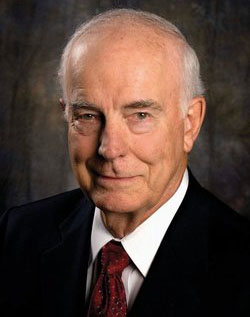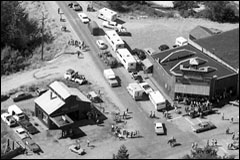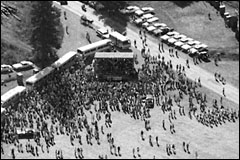home | internet service | web design | business directory | bulletin board | advertise | events calendar | contact | weather | cams

|
It Wasn't Ted Bundy part one of three | part two >> | part three >>  Former Governor Daniels J. Evans. Photo courtesy of University of Washington Former Governor Daniels J. Evans. Photo courtesy of University of Washington
It’s widely believed on both sides of the Cascades that notorious serial killer Ted Bundy technically was the first person to officially cross the North Cascades Highway as Gov. Daniel J. Evans’ driver on opening day Sept. 2, 1972. Even the Washington State Historical Society’s Columbia Magazine of Northwest History reported this as fact in 2011. It’s not true, Evans told Grist. “He certainly wasn’t driving my car,” Evans said. His driver that day was the late Bill Lathrop, the Washington State Highway Patrol trooper who was Evans’ long-time bodyguard and driver, said Evans. The persistent myth apparently is based on Bundy’s own claims in interviews, according to Evans. “It’s totally bogus,” he said. “They even had him babysitting our boys. It’s just absolutely nonsense. It never happened.” But Bundy was in Winthrop that day. He was hired by the governor’s re-election campaign to pass out campaign literature and buttons, said Neil McReynolds, who was Evans’ press secretary at the time. It would have been illegal for Bundy, who wasn’t a state employee, to drive a state-owned vehicle, McReynolds added. At a Winthrop gathering that McReynolds recalls at Sun Mountain on the evening of Sept. 1, he introduced Bundy to Richard W. Larsen, the Seattle Times reporter who would become one of Bundy’s biographers. (Bundy’s documented killing spree began in 1974.) An estimated 3,000 people gathered in Winthrop on that day for festivities that began at 10:30 a.m. at the ball field, according to a 1972 account in Okanogan County Heritage magazine. There was a pancake feed and ribbon cutting by Evans and highway booster Les Holloway of Twisp, who wielded enormous shears. Evans awarded a plaque commemorating his work to the sons of the late Methow orchardist George D. Zahn, the head of the state highway commission and the man credited with making the highway a reality.  Governor Evans in the Winthrop ball field bleachers on September 2, 1972. Behind him are Winthrop ‘49ers Day royalty Linda Wildman Dunn, Gloria Arbogast Royse and Laurie Cotner Buzzard. Photo courtesy of Department of Transportation Photograph Collection, Washington State Archives. Governor Evans in the Winthrop ball field bleachers on September 2, 1972. Behind him are Winthrop ‘49ers Day royalty Linda Wildman Dunn, Gloria Arbogast Royse and Laurie Cotner Buzzard. Photo courtesy of Department of Transportation Photograph Collection, Washington State Archives.
“George Zahn was one of the ultimate figures [in getting the highway built.] He convinced me,” Evans told Grist. The North Cascades Highway Association (Jack Abrams and Les Holloway of Twisp, Lyle Walker of Winthrop and Jack Wilson of Mazama all served as presidents of the association) hosted the events, along with the Washington State Highway Commission and the Washington State Department of Highways (WSDOT). All manner of dignitaries, officials and bureaucrats were in attendance, including Democratic Congressman Tom Foley, who joined the Republican governor in his vehicle for part of the trip over the mountains, according to McReynolds. The new highway was closed to eastbound traffic to accommodate the westbound caravan from Winthrop. The entourage stopped in Newhalem for a west side ribbon cutting and a speech by U.S. Sen. Henry M. Jackson. Then it rolled on to Sedro Woolley’s football field for a salmon barbecue. Evans, 86, says his best guess is that perhaps 100 to 150 vehicles followed him across the pass; 21 buses appear in an aerial photo taken of the ball field in Winthrop as the crowd is assembling for the ceremonies. “I was always very much a proponent of the highway as governor,” said Evans, a civil engineer. Asked if he still believes the sometimes contentious highway was worth building, he answered: “Absolutely.” He said he and his wife, Nancy, drove over the highway to the Methow as recently as last year. “It was marvelous.” Evans, elected in 1965 at age 39 to the first of three terms as governor, got his introduction to the highway in 1966 when Zahn invited him on a horseback excursion along the route from Silver Star camp to Ross Lake. Thirty horses and 20 mules were required for what became the governor’s historic walkabout through the Cascades, according a Washington State Department of Transportation account by highway engineer Richard Carroll. An avid hiker and wilderness enthusiast, Evans said he eagerly accepted because he thought the trip “was a great idea.” But, he confessed, “I rode about a quarter of a mile” before getting off his horse and walking the rest of the route leading his ride. “I didn’t like horses very much.” Memorably, the horse his six-year-old son Dan was riding was attacked by a swarm of yellow jackets. “They were mad as hell. They stung his horse, and the horse started to leap around and ran through the trees with Danny holding on for dear life,” Evans recalled. When the entourage arrived at Ross Lake three or four days later, a helicopter was waiting to fly the governor over the Cascades so he could see the route of the highway from the air. “Oh, it was an absolutely extraordinary trip,” Evans said, still marveling 46 years later at what he saw from high above the rugged Cascades that day. On top of a steep precipice, the pilot put the aircraft down on a tiny flat spot not much bigger than the helicopter’s footprint, Evans said. As he surveyed the jaw-dropping landscape on all sides, Evans recalled feeling a little strange. “You’re supposed to climb up to these mountains,” he remembers thinking. “But it was a thrill.” “I love wilderness, and I have proposed more wilderness than just about anybody else,” Evans said. “But I always believe in access. Otherwise, you lose the enthusiasm of people for wilderness because they can’t get into it.” This, he added, is why he disagrees with those who argue that unused wilderness roads should be allowed to revert back to nature or become accessible only to people who can hike in on trails. As a tactic for rallying support for preserving nature, keeping people out of it eventually backfires, Evans argued. “They defeat their own purpose.”
Despite the governor’s enthusiasm, the highway wasn’t warmly welcomed by everyone on either side of the Cascades. Even 25 years after it opened, well-known Seattle environmental activist, author and highway opponent Harvey Manning told The Spokesman-Review: “It’s still a travesty.” The North Cascades Conservation Council that Manning belonged to had formed in 1957 when the founders, some of whom were active in the Sierra Club, learned of the highway’s likely purpose as a Cascade resource-extraction conveyor belt. The council became the prime mover behind the lobbying effort that got the North Cascades National Park established in 1968, putting mining and logging off-limits in areas surrounding the highway. Before that happened, a Senate hearing on the bill was held in Seattle. At the time, no consensus had been reached among the state’s agencies and citizens about what exactly, if anything, should be done about the lands surrounding the highway, Evans said. The state was still going through the process of studying the matter. So in his testimony to the Senate committee, Evans said he tried to speak “very carefully” about the various views within the state about the park proposal. But when the senators on the committee asked him to state his own opinion about the best use of the land surrounding the highway, Evans replied: “`If I had my choice, I’d protect it.’ And that became their view of the state’s position,” Evans said. “I probably took a couple or three steps further than the official position we had been talking about. But I didn’t think that there was much question but that we needed to protect the whole area.” Due to the danger from avalanches and cost of building snow sheds, it was always understood the highway would not be open during winter, according to Evans. Today WSDOT spends $250,000 each spring to clear the highway, said agency spokesman Jeff Adamson in Wenatchee. The cost of snow clearing has been reduced over the years due to more effective equipment and using salt on the pavement; this prevents the snow from freezing to the pavement during winter, Adamson added. The traffic over the highway varies markedly. According to WSDOT’s estimates, between Memorial Day and Labor Day an average of 1,400 vehicles a day make the crossing, said Adamson. Earlier and later in the season, it averages 900 vehicles per day, he said. Evans, asked if he thinks the highway could have been built today, the former legislator, governor, U.S. senator and president of The Evergreen State College answers: “Probably not. We were much better off in those days.” For one thing, the federal government was contributing to the state’s interstate highway construction fund, so the state could use its own money elsewhere on such projects as the North Cascades Highway, he said. But, Evans noted, “As is the case with most big projects, it’s always a very small group that’s so intent on getting it done that they get it done.” 8/27/2012 Comments Great article. I also enjoyed seeing the old photos with fantastic views of what town looked like in 1972. Kristen Smith Winthrop Great seeing the three princesses.....All who are still around. I hope they get a chance to read this article and see the pics. Barry Stromberger Thanks much for clearing that up. I've heard the story for many years. Richard Hart Thanks so much Karen and Solveig for these three articles. They concisely covered much of the valley's history and showed the changes from some earlier residents. I'm so glad that they still feel it is a great place to live, even after all the changes, and I thank them for still welcoming us to their valley. Dennis O'Callaghan Winthrop Once again I'm impressed with the thoughtful and in depth look at subjects that affect us here in the Methow. Thank You Grist! Don Ashford Rockview Dance Hall Are you sure it wasn't Ted Bundy? Not the driver - but in the lead vehicle? On September 2,1972, I supported my Grandfather - Lester Duncan Hollaway (correct spelling)in the North Cascades ribbon cutting ceremony with Governor Dan Evans. As your article states, the Governor and my grandfather used over sized scissors to cut the ribbon - chronicled by the often shown news footage. My Grandfather was a Methow 1909 homesteader, a County Commissioner, and a passionate supporter of the new highway. Following the cutting, the Governor, his wife, my grandfather and I boarded a motor home that lead a huge line of cars and buses - first to Washington Pass and then on to New Halem for still another Ceremony. In addition to the four of us on the motor home, there was a driver - who I was told was a state patrolman - and one other person - a good looking young man whose job it was to serve all of us refreshments throughout our trip. I did not get his name but always assumed this was Ted Bundy - not the driver, but never the less , in the first vehicle over the the pass ! Les Duncan McCallum Gig Harbor, WA
|


